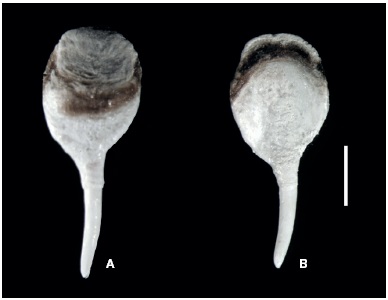There are currently 72 known species of the Teredinidae family, and these are distributed throughout the seas and oceans around the world (Bouchet, 2013; Turner, 1966). Fourteen species of this family have been reported in the Caribbean Sea (Abbott, 1974; Díaz & Puyana, 1994; Miloslavich et al., 2010; Turner, 1966), of which 11 have been recorded in the Venezuelan coast (Ewald, Severeyn, & Espinoza, 1984; Nair, 1975; Turner, 1954; 1955; 1966). There have been no recorded observations of new teredinids in Venezuela since the last study of boring molluscs done by Ewald et al. (1984) in the Maracaibo Lake. Here Spathoteredo spatha is recorded for the first time in Venezuela. This observation also represents the first record of a Teredinidae species in this country in 30 years.
Material examined
A total of 17 live specimens of S. spatha were collected between October 2007 and February 2014, in Punta de Piedras Lagoon, Margarita Island, Venezuela. All of them were found boring into sunken wood of Rhizophora mangle . The samples were preserved in ethanol 70%, with some being deposited to the Malacology collection at Oceanology Museum Hno. Benigno Román of the Marine Station Research of Margarita (EDIMAR), Margarita Island, Venezuela, under the Catalog number MOBR-M-3985. Also, for the correct identification of our samples these were compared with specimens of the Malacology Collection at Museum of Comparative Zoology (MCZ), Harvard University, Cambridge, Massachusetts.
Spathoteredo spatha (Jeffreys, 1860)
Description
Shell with a heavy brown periostracum; valves small, globose, anterior face with numerous denticulate ridges, typical of Teredinidae (Turner, 1966). Pallets are oval with a band of periosracum on the median area of the outer face and cover a small part of the internal face. The upper portions of the blade covered with a calcareous deposit, segmented having a ribbed appearance (Fig. 1). The size of the pallets varied between 2.38-3.96 mm. The siphons are united except at the tip. All specimens were collected from sunken wood of Rhizophora mangle between 1.5-2 meters deep.
Comparative material
Indian River, Florida, USA (MCZ-356880); Puerto Cortés, Honduras (MCZ-227262); Fajardo, Puerto Rico (MCZ-170703); Galeta Island, Panama (MCZ-356879); Santa Marta, Chengue, Colombia (MCZ-278056).
Geographical distribution
Atlantic North (West coast), USA (Turgeon et al., 1998); Atlantic North (East coast): United Kingdom, England (Turner, 1966); Gulf of Mexico and Caribbean Sea (Turner, 1966).
The specimens examined are morphologically similar to the descriptions of Turner (1966) and the specimens which were compared from the Museum of Comparative Zoology. However, these show some differences with the illustration pallets of S. spatha presented by Turner (1966), since the figure shows a whitish papillose calcareous deposit in the upper portion of the blade and this feature is not present in the pallets of our specimens, nor in the majority of comparative specimens from the museum.
In Teredinidae species it is common to find high intraspecific variation that is evident in the morphology of the pallets and valves, which are the principal structures used for the identification of the species (Turner, 1966). This variation is a product of the boring life style and environmental conditions (Borges, Merckelbach, Sampaio, & Cragg, 2014; Cragg, Jumel, Al-Horani, & Hendi, 2009) and this was generated as a result of the erroneous identifications in the past (Borges et al., 2014); a fact that can be demonstrated by the number of existent synonymy (Turner, 1966).
Spathoteredo spatha was described for the first time by Jeffreys (1860), and named Teredo spatha , this description was based on specimens obtained from driftwood from Guernsey's coast, England. Later, Roch (1931) proposed a new name (Teredo molli ) for specimens of S. spatha collected from driftwood in the Atlantic Ocean. The organization of the species into the currently known genus Spathoteredo, which consists of the 2 species S. spatha and S. obtusa , did not occur until 1966 when R. Turner proposed this in the book The Survey Illustrated Catalogue of the TeredinidaeThe first species has a distribution range principally from Caribbean Sea to both sides of the North Atlantic and the South Atlantic waters. However, there is a report of S. spatha in European waters (Gofas, 2013; Gofas, Le Renard, & Bouchet, 2001), but this is not considered an established species for this zone because all specimens were found either in driftwood carried mainly by the Gulf Stream to the British Isles or in driftwood in the Mediterranean (Borges et al., 2014). The second species is distributed throughout the Pacific Ocean (Africa (East coast), Madagascar, Red Sea, Persian Gulf, Pacific Islands, Southeast Asia, Indonesia, New Guinea, Philippine Islands) (Turner, 1966).
The collection of S. spatha specimens was carried out in 2 different years in the locality of Punta de Piedras Lagoon, so it can therefore be concluded that this species is established in this locality.
The principal author is grateful to Adam Baldinger, Curatorial Associate of Malacological Collection of the Comparative Zoology Museum of Harvard University (MCZ), for allowing the review of the Teredinidae samples of the collection in order to make comparisons with the specimens used in this study. Thanks also to Alex Carter for his helpful comments on the translation of the manuscript.











 nova página do texto(beta)
nova página do texto(beta)



